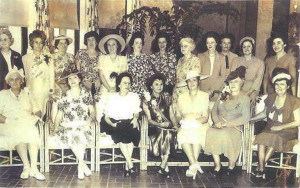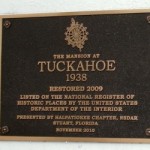Stuart Florida DAR Historical Markers

The Palm City and Stuart Florida area has a long and colorful history that the local residents have gone to no small effort to document. One group in particular, The Palm City/Stuart Halpatiokee chapter of the Daughter of the American Revolution came into existence, in part, to chronicle those events that lead to what the Treasure Coast area is today.
The name the Seminole Indians gave to the St. Lucie River, “river of large alligators” was adopted by the Halpatiokee Chapter and the Organization came into existence on January 20, 1949. In so doing, they too became part of the story.
They took it upon themselves to set markers at locations of significant historical importance. Their intent is to educate the reader about the site being viewed. Listed below are two of the markers currently set.
The Mansion at Tuckahoe.
..
 The Stuart DAR chapter marker at The Mansion at Tuckahoe is located on the top of a hill at 1921 North East Indian River Drive in Jensen Beach, Martin County, FL overlooking the Indian River. Archeologists have determined that more than 4,000 years ago Native Americans created a 30 foot tall mound of oyster shells which makes this site one of the tallest sites in the state. Prehistoric pottery has also been found in the mound. In 1938 the 14,000 square foot mansion was built on top of the Indian mound. The text on the marker is as follows below:
The Stuart DAR chapter marker at The Mansion at Tuckahoe is located on the top of a hill at 1921 North East Indian River Drive in Jensen Beach, Martin County, FL overlooking the Indian River. Archeologists have determined that more than 4,000 years ago Native Americans created a 30 foot tall mound of oyster shells which makes this site one of the tallest sites in the state. Prehistoric pottery has also been found in the mound. In 1938 the 14,000 square foot mansion was built on top of the Indian mound. The text on the marker is as follows below:
The Mansion at Tuckahoe – 1938 – Restored 2009
Listed on the National Register of Historic places by the United States Department of the Interior.
Presented by Halpatiokee Chapter, NSDAR Stuart, FL November 2010
[flexiblemap address=”1921 North East Indian River Drive in Jensen Beach, Martin County, FL” zoom=”14″ title=”1921 North East Indian River Drive in Jensen Beach, Martin County, FL” width=”100%” description=”The Mansion at Tuckahoe”]
Gilbert’s Bar “House of Refuge” Prehistoric Site.
..
 The Stuart DAR chapter marker at Gilbert’s Bar House of Refuge, is situated on the coastal rocks of the Anastasia formation, one of the most prominent geologic outcroppings along the entire Eastern seaboard. The address is 301 SE MacArthur Boulevard, Hutchinson Island, Stuart, FL. The text on the marker is as follows below:
The Stuart DAR chapter marker at Gilbert’s Bar House of Refuge, is situated on the coastal rocks of the Anastasia formation, one of the most prominent geologic outcroppings along the entire Eastern seaboard. The address is 301 SE MacArthur Boulevard, Hutchinson Island, Stuart, FL. The text on the marker is as follows below:
Europeans arriving at Hutchinson Island in the 16th century found the island populated by hundreds of Native Americans living in settlements bordering both the Atlantic Ocean and the Indian River.
The rich marine environment provided these Native Americans a diet of fish, shellfish, and sea animals, including whale and sea turtle. The land provided them with deer, bear, snakes, and edible and medicinal plants.
Because of the lack of hard stone, tools and weapons were fashioned from bone, shell, and wood. Vessels were made from gourds, wood, and clay. Wooden dugout canoes efficiently ferried groups and families from the Atlantic Ocean to the St. Lucie and Indian Rivers.
Archaeologists have documented numerous prehistoric sites on Hutchinson Island. Many sites have been damaged by hurricanes and looters. Gilbert’s Bar House of Refuge was built on top of a prehistoric settlement dating to as early as circa 800 BC.
By the late 18th century, disease, warfare, and slave raids had decimated the Native American populations. There are no known decedents of the first people of Hutchinson Island.
[flexiblemap center="27.199167,-80.165556" marker="27.199167,-80.165556" title="Gilbert's Bar House of Refuge" width="100%" zoom="14"]

